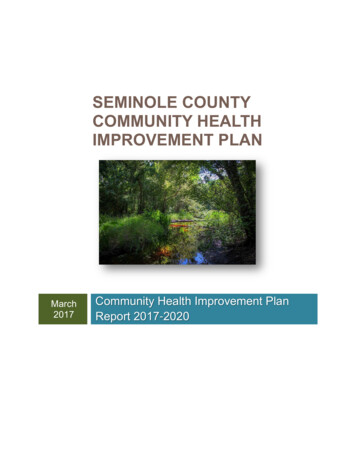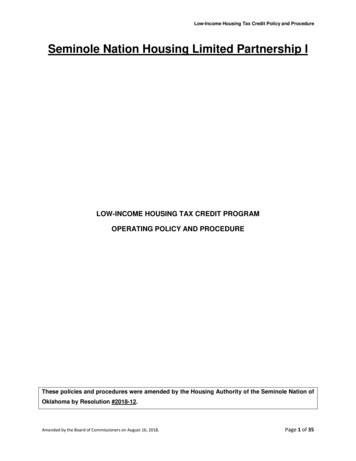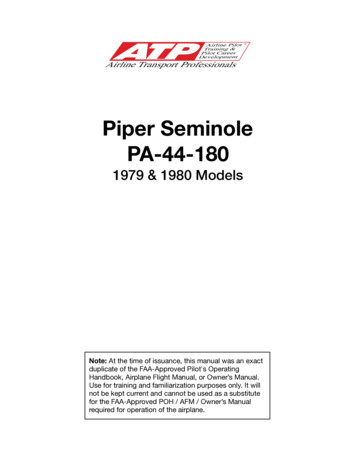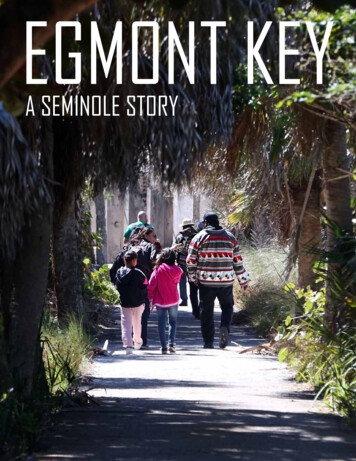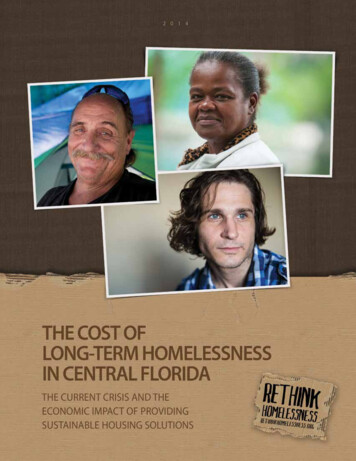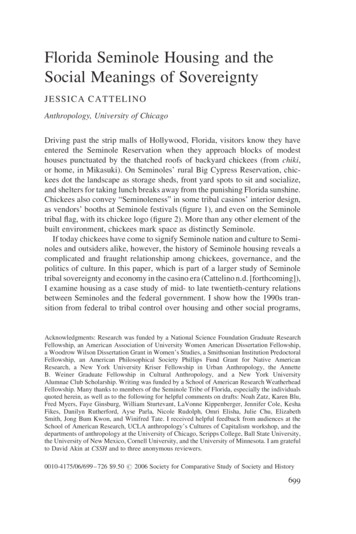
Transcription
Florida Seminole Housing and theSocial Meanings of SovereigntyJESSICA CATTELINOAnthropology, University of ChicagoDriving past the strip malls of Hollywood, Florida, visitors know they haveentered the Seminole Reservation when they approach blocks of modesthouses punctuated by the thatched roofs of backyard chickees (from chiki,or home, in Mikasuki). On Seminoles’ rural Big Cypress Reservation, chickees dot the landscape as storage sheds, front yard spots to sit and socialize,and shelters for taking lunch breaks away from the punishing Florida sunshine.Chickees also convey “Seminoleness” in some tribal casinos’ interior design,as vendors’ booths at Seminole festivals (figure 1), and even on the Seminoletribal flag, with its chickee logo (figure 2). More than any other element of thebuilt environment, chickees mark space as distinctly Seminole.If today chickees have come to signify Seminole nation and culture to Seminoles and outsiders alike, however, the history of Seminole housing reveals acomplicated and fraught relationship among chickees, governance, and thepolitics of culture. In this paper, which is part of a larger study of Seminoletribal sovereignty and economy in the casino era (Cattelino n.d. [forthcoming]),I examine housing as a case study of mid- to late twentieth-century relationsbetween Seminoles and the federal government. I show how the 1990s transition from federal to tribal control over housing and other social programs,Acknowledgments: Research was funded by a National Science Foundation Graduate ResearchFellowship, an American Association of University Women American Dissertation Fellowship,a Woodrow Wilson Dissertation Grant in Women’s Studies, a Smithsonian Institution PredoctoralFellowship, an American Philosophical Society Phillips Fund Grant for Native AmericanResearch, a New York University Kriser Fellowship in Urban Anthropology, the AnnetteB. Weiner Graduate Fellowship in Cultural Anthropology, and a New York UniversityAlumnae Club Scholarship. Writing was funded by a School of American Research WeatherheadFellowship. Many thanks to members of the Seminole Tribe of Florida, especially the individualsquoted herein, as well as to the following for helpful comments on drafts: Noah Zatz, Karen Blu,Fred Myers, Faye Ginsburg, William Sturtevant, LaVonne Kippenberger, Jennifer Cole, KeshaFikes, Danilyn Rutherford, Ayse Parla, Nicole Rudolph, Omri Elisha, Julie Chu, ElizabethSmith, Jong Bum Kwon, and Winifred Tate. I received helpful feedback from audiences at theSchool of American Research, UCLA anthropology’s Cultures of Capitalism workshop, and thedepartments of anthropology at the University of Chicago, Scripps College, Ball State University,the University of New Mexico, Cornell University, and the University of Minnesota. I am gratefulto David Akin at CSSH and to three anonymous reviewers.0010-4175/06/699–726 9.50 # 2006 Society for Comparative Study of Society and History699
700JESSICA CATTELINOFIGURE 1Vendors at a tribal museum festival. Author’s photo.enabled by tribal gaming revenues, shifted modes of governance previouslyestablished through Seminoles’ mid-century reliance on federal governmentfunding and administration. Tracing Seminole housing offers insight into theongoing processes of settler coloniality in the United States, much as scholarshave examined housing as a domain of colonialism in other periods and locales(Celik 1997; Comaroff and Comaroff 1992; Mitchell 1991; Wright 1991),including among First Nations in Canada (Harris 2002; Perry 2003). Yet Seminole housing not only tells a story about colonialism, but also illuminates thepossibilities, limits, and unexpected entailments of tribal sovereignty.Tribal sovereignty is most often understood to mean the political authorityof American Indian tribes over their citizens and territory, and it is based bothon indigenous claims to precolonial governmental status and on colonial andUnited States recognition of this status in law and practice (Barker 2005;Deloria 1979; Deloria and Lytle 1984; Wilkins and Lomawaima 2001).Although most often claimed and challenged by lawyers, bureaucrats, andpolitical activists, tribal sovereignty is not only a formal legal status:instead, I also understand it ethnographically to be Seminoles’ shared assertions, everyday processes, intellectual projects, and lived experiences of political distinctiveness (see also Warrior 1994: 87; Womack 1999: 51).I aim for this paper to demonstrate the historical relations and everydaypractices through which tribal administration and economy take form andmeaning, and by which they are most directly linked to tribal sovereignty.
SOCIAL MEANINGS OF SOVEREIGNTY701FIGURE 2 Seminole flag (digital). Courtesy of The Seminole Tribe of Florida.Put another way, I am implicitly concerned to maintain a productive tensionbetween Foucault’s seemingly distinct modes of sovereignty and governmentality, where sovereignty connotes a pre-modern juridical order based on right,law, and territory, and governmentality focuses on the modern constitution ofsubjects through circulatory power tactics and fields.1 If Foucault limits sovereignty’s domain to theories of right, my research shows that overly juridicaland unitary understandings of sovereignty blind us to the lived experiencesand multiplicities of sovereignty. The case of Seminole housing, moreover,shows family and economy—usually linked to governmentality or relegatedto an outside of politics (Agamben 1998)—to be at the center of sovereignty.Taking indigenous sovereignty seriously forces us to conceptualizesovereignty beyond the European nation-state and the model of sovereignautonomy, both of which have dominated social and political theories ofsovereignty from Foucault to Agamben, Hobbes to Rousseau.CHICKEES TO CBSIn order to understand the significance of recent casino-funded Seminole tribalhousing programs, it is essential to trace mid-century federal and philanthropicefforts to move Seminoles out of matrilineal extended family residences intostandardized single-family houses. As a modernizing project, federal housingfor Seminoles instituted new spatial and civic orders, which in turn shaped themotivations for, and consequences of, subsequent gaming-era Seminoleefforts to control tribal housing administration.1See Foucault’s discussion of sovereignty, power, and methodology in the “Two Lectures”(Foucault 1980), his lecture “Governmentality” (Foucault 1991), and his discussion of sovereigntynear the end of the first volume of The History of Sexuality (Foucault 1990[1976]).
702JESSICA CATTELINOClan Camp LivingBefore the nineteenth-century Seminole Wars (1817 – 1818, 1835 –1842,1855– 1858), during which the United States pushed some Seminoles southinto the Everglades and forcibly removed the majority to present-day Oklahoma, Seminoles in northern Florida lived in multiple-story wood framehouses.2 After being pushed into the southern swamps, Seminoles began tobuild and reside in chickees, open-sided thatched structures with roofs of palmetto leaves attached to rafters, secured by corner support posts of cypress orpalm logs. Chickees were well suited to the heat, humidity, and seasonalfloods of the southern Florida swamps, and during the unstable war yearsthey could be built and dismantled quickly.Early twentieth-century Seminole households, or groupings based on residential propinquity and shared activities (Yanagisako 1979), organized andexpressed a variety of social, economic, and political relationships. Households formed the basic economic unit, and the matrilineal clans aroundwhich they were organized comprised the central political units. A household,often called a “camp” or “village” in the academic and government literatures(and in present-day Seminole English), consisted of multiple chickeesarranged around a central cooking chickee. The central fire, which Seminolesoften speak about as the “heart” of the camp and a symbol of life itself, burnedcontinuously (figure 3).3 Betty Mae Jumper’s (Snake clan) published rendering of life in “The Village” during her early 1900s childhood identifies the fireas a key site of adult social life (Jumper 1994). Residents utilized additionalchickees for sleeping, storage, and working. Camps were organized accordingto uxorilocal patterns; thus, they included women from a single clan, theirchildren, their husbands (necessarily members of other clans), and unmarriedmale clan relatives. Clan property, as many Seminole women emphasized tome, generally passed through women in the matriline: women and their clanrelatives owned the chickees associated with a camp, even though husbandswere responsible for building chickees and for contributing to the householdeconomy (Kersey and Bannan 1995: 197). As Harley Jumper (clanunknown) told anthropologist William Sturtevant in the early 1950s: “If youmarry a girl, you have to learn how to make houses, and you have to helpher kinfolks in the things they do. That’s the way we teach our young ones”(WCSF, 1951– 1952, Box 1). Housing thus represented more than shelter: italso fulfilled social obligations between clans and marriage partners.2For an account of Seminole ethnogenesis see Sturtevant (1971); for a general treatment ofFlorida Seminole history and ethnology see Sturtevant and Cattelino (2004).3For a description of nineteenth-century Seminole chickee camps see MacCauley’s 1881account (MacCauley 2000). Spoehr’s description of Cow Creek Seminole camps around and onthe Brighton reservation dates from fieldwork conducted in 1939 (Spoehr 1944). Nabokov andEaston’s Native American Architecture includes a discussion and illustrations of chickees (1989).
SOCIAL MEANINGS OF SOVEREIGNTY703FIGURE 3 John Jumper’s camp, 1908. Courtesy, National Museum of the American Indian,Smithsonian Institution (N02960). Photo by Mark R. Harrington.When a marriage broke up, a man returned to his own clan’s camp, while awoman retained her chickees; an ex-husband had neither rights over, norresponsibilities to, his former wives and children (Spoehr 1944).Seminoles’ post-war houses were not permanent, nor did they function asmetaphors for family and group stability (in contrast to the ideology of thesingle-family home discussed below). They were widely dispersed, oftenmiles apart. Many Seminoles left their camps for long periods of time, onhunting and trading trips, to visit relatives, or to live and work in tourist attractions. Older Seminoles remember camp life as mobile and flexible: whengarden soil became less productive, nearby game was depleted, or campconditions became unsanitary, all residents picked up and relocated.Onto the Reservation: The Transition BeginsBeginning in the 1930s, Seminoles increasingly moved onto reservation landsthat had been federally designated for their use. This began the fifty-yearperiod in which the federal government exercised the most control over Seminoles’ daily lives and governmental operations. American Indian reservationscarry significance far beyond their spatial organization or formal legal status.Thomas Biolsi has analyzed reservations as spatial modes of governmentality,whereby modern individuals (and subjects) were produced (1995). AmericanIndian scholars and artists often represent reservations with ambivalence,acknowledging their intrinsic constraints while recognizing their criticalrole in producing indigenous identities and power (Alexie 1995; McMaster1998). Former tribal chairman James Billie (Bird) explained that many
704JESSICA CATTELINOSeminoles did not want to move onto reservations: “You wouldn’t either.That’s a concentration camp, that’s what it in fact is. Limiting your abilityto move around like you used to” (13 Apr. 2001).4 Because the American government had concentrated Seminole settlement for forced Western removalduring and after the Seminole Wars, many Seminoles feared that if theymoved onto the new reservations they would be transported to Oklahoma.5Thus, U.S. governmental control over indigenous residence took on historically particular connotations of subjugation and genocide. Seminoles’ongoing ambivalence toward reservation space is exemplified by the currentprohibition on holding the annual Green Corn Dance, an important ritualevent, on reservation land. Nonetheless, Seminoles’ motivations for movingonto reservations were many: during this Florida boom time some sought stability after being pushed off their lands by new non-Indian landowners, somemoved because the Bureau of Indian Affairs (BIA) offered on-reservationjobs as part of Indian New Deal federal employment programs (Kersey1989), while others clustered on reservations as they converted toChristianity.6By the 1950s on the Dania (later Hollywood) Reservation, chickeedominated Seminole settlements had become a “problem” that several localcharitable organizations sought to solve by raising money for new Seminolehomes. The Friends of the Seminoles, the Florida Federated Women’sClubs, and other philanthropic organizations took up the cause, placing advertisements in local newspapers and working with business leaders to raise funds(Jumper and West 2001: 144 – 49). Financing was an obstacle becauseAmerican Indian reservation lands were and are held in trust by the federalgovernment, and thus are inalienable. As a result, banks and other lendingagencies were unwilling to finance reservation development and mortgages.By 1956, however, local charities began to work with the local IndianAgent to build six new wood-frame reservation houses at Dania. This setthe stage for the federal government housing projects that soon followed.A turning point in Seminole housing was the 1957 tribal reorganizationunder the 1934 Indian Reorganization Act, which fundamentally altered Seminoles’ financial and administrative relationships with the federal government(Kersey 1996). Since the American conquest, Florida Seminoles had occupied4Fieldwork interview dates are indicated in parentheses.Government officials and white philanthropists had made several late nineteenth- and earlytwentieth-century efforts to convince Seminoles to move onto reservations, with little success(Covington 1993: ch. 9).6The three main reservations are the rural Big Cypress Reservation, located in the Big Cypressswamp in south central Florida; the rural Brighton Reservation, just off the northwest shore ofLake Okeechobee; and the urban Hollywood Reservation. These reservations date to the 1930s,and they are the home of most Seminoles. In the late twentieth century, Seminoles added smallreservations at Immokalee, a farming community with an established Seminole presence, andin the cities of Tampa and Fort Pierce.5
SOCIAL MEANINGS OF SOVEREIGNTY705an uncertain space between individual citizenship and tribal status, ableneither to profit from private land ownership nor to benefit from governmentprograms designated for federally recognized American Indian tribes.7 Aftertheir 1957 reorganization, however, Seminoles became eligible for myriadfederal benefits designed for tribes, including housing programs stemmingfrom the 1949 Housing Act. The timing was fortuitous: John F. Kennedydecried substandard Indian housing during his 1960 campaign, and his andJohnson’s administrations implemented new federal Indian housing programsunder the auspices of the Public Housing Administration, the Office of EqualOpportunity, and the BIA (Biles 2000). Some programs offered grants forimpoverished Indian families seeking housing, others provided federalbacking for tribes’ revolving credit loan programs, and still others offeredaffordable housing through mutual self-help initiatives. Many Seminolesstill vividly recall logging the 590 hours of labor required for home ownershipunder the mutual self-help program.Government administration and citizenship are cultural processes woveninto the limitations and possibilities of everyday life. For American Indians,who since the Marshall Supreme Court cases of the 1830s have been legallycategorized as “wards of the state,” social reproduction therefore takesplace partly in relation to settler state policies and administrative activities.Prior to reorganization, most Seminoles had viewed radical independencefrom the federal government as the only hope for sustaining a healthy lifestyle,and to this day Seminoles speak of being “unconquered” because they “neversigned a peace treaty” with the United States. Yet from the 1950s through the1970s, before tribal gaming realigned the possibilities and structures ofgovernance, the BIA Seminole Agency staff administered almost all tribalprograms. The legacy of mid-century BIA dependency is evident today inadult Seminoles’ extraordinary familiarity with, and mastery over, the intricacies of federal regulations and entitlements.Despite the BIA’s heavy hand, Seminole housing programs were not asimple case of top-down governmental paternalism. Seminoles worked hardto secure new housing. Several adults explained that as schoolchildren inthe 1960s they longed for houses because it was difficult to study in chickees,especially those lacking electricity for light. By the late 1960s, a new generation of tribal political candidates campaigned on platforms that includedhousing development. Their political positions echoed both the mid-centuryassimilation and equality ideals of post-New Deal liberalism and, to someextent, the sharp critiques of state-based inequality leveled by 1960s RedPower activists. By 1966, approximately 42 percent of all Seminole families7As explained in a 1956 pre-reorganization letter from Acting Commissioner of the Bureau ofIndian Affairs H. Rex Lee to Hon. Paul G. Rogers, a U.S. Congressman from Florida, the BIAcould not release funds for Seminole housing because Florida Seminoles had not yet attainedfull recognition by the United States (RQP, Box 2).
706JESSICA CATTELINOFIGURE 4 A 1960s CBS home, probably on the Big Cypress Reservation. Courtesy, NationalAnthropological Archives (Ethel Cutler Freeman Papers, Neg. 2002-1430).had abandoned their chickees for four walls, indoor plumbing, ovens, andother amenities offered by their new government-built CBS (concrete blockstructure) houses (figure 4); on the Hollywood Reservation the number was64 percent (Seminole Tribe of Florida 1966b, RQP).8 Federal programsbrought many Seminoles a step closer to reaching the American Dream ofmodern home ownership and class mobility. Yet, the new housing developments also revealed tensions between competing American and Seminolevalues of citizenship and sociality, most evident in the domains of kinship,gender, and domestic space.REMODELING FAMILY AND GENDERWhen I asked middle-aged and elderly tribal members what it was like tomove from chickee camps into single-family housing developments, theygenerally coupled pride in progress with a lament for the breakdown of theextended family and the erosion of the clans. As stated above, clans organized8Some Seminoles continued to live in chickees: at Big Cypress, many families lived in campsuntil the 1980s, some by choice but many by economic necessity. Others lived in camps at touristattractions during the winter tourist season (West 1998). Some eventually joined the MiccosukeeTribe and lived in clan camps along the Tamiami Trail, while other politically unaffiliatedSeminoles preferred to live off the reservations in clan camps built on private land owned bysympathetic non-natives.
SOCIAL MEANINGS OF SOVEREIGNTY707economic, social, and political life, so housing transition did not simply affectindividuals: it had broad implications for the Seminole public. As ElizabethPovinelli (2002b) and others have argued, indigenous citizenship and entitlement within settler modernity are contested upon the terrain of kinshiprelations; scholars have made similar claims for the mechanisms by whichcolonialism enters into, and relies upon, kinship and intimacy as sites ofgovernance (Chatterjee 1993; Kanaaneh 2002; Stoler 2002).The BIA Seminole Agency created housing policies that privileged nuclearfamilies, for example drawing up housing blueprints based on the assumptionof nuclear family habitation and initially extending homesite loans and leasesonly to nuclear families with male heads of household. In 2001, then-directorof the Housing Department Joel Frank (Panther) emphasized the importanceof clan living, lamenting, “housing has gone a long way to destroy a lot ofit. We have taken the family out of all that support that was there in thevillage concept and isolated them, so they have had to fend for themselvesas an independent unit” (9 Jan. 2001).Some Seminoles, including former Housing Commissioner Jacob Osceola(Panther), speculated that the BIA and Housing and Urban Development(HUD) intentionally disrupted clan-based residence by distributing housingwithout regard for clan settlement patterns. Osceola argued that this waspart of a larger government project to make Seminoles more “American”(10 Oct. 2000). His theory is consistent with available evidence that theBIA was engaged in multi-pronged efforts to promote the nuclear family asthe basis for Seminole social and economic life. These policies resultedneither from benign government misunderstanding nor from direct staterepression. Instead, they represent a particular mode of governance exercisedby the United States toward Seminoles that is common to “internal colonialism” (Paine 1984; Schein 2000) or, more specifically, “welfare colonialism,”in which the political projects of state governance are administered in part viasocial services that attempt to “modernize” and regulate family structureamong internal minorities and indigenous peoples (Paine 1977).For men, moving into BIA housing developments transferred family authority from the maternal uncle to the father. Previously, a man’s responsibility tohis wife’s children generally was as a breadwinner, not a teacher or disciplinarian; maternal uncles, not fathers, passed clan-specific knowledge,discipline, and (often) property to their sisters’ children. By contrast, theBIA Seminole Agency emphasized the importance of biological fatherhood,as in the 1966 Community Action Program: “The Seminole ExtensionAgent has a unique job in her role to assist the Indian families to learn tocope with the problems of modern living. From a culture in which thewoman assumed almost complete responsibility for the children, the fathermust learn his role in the modern family” (Seminole Tribe of Florida1966a: 5; ECFP). Southern Baptist missionaries promoted fatherhood and
708JESSICA CATTELINOprovided a religious model for its expression, and it cannot be coincidental thatSeminole Baptists were especially quick to move into the new houses. TheBIA also bolstered fatherhood by extending housing loans to male heads ofhousehold. In one sense, men gained authority over their wives and childrenthrough their roles as nuclear family fathers and heads of household, but inanother sense men lost authority through their diminishing roles as maternaluncles and clan elders.Seminole women also reconfigured ties of kinship and sociality duringhousing transition. Elsie Bowers (Snake), a middle-aged woman originallyfrom the Brighton Reservation and general manager of the Seminole Tribeof Florida, Inc. tribal smoke shops, responded to my question about housingwith a typically gendered account. Bowers’ mother died when she was eightyears old, so Bowers’ “really traditional” maternal grandmother took careof Bowers and her five siblings. In 1970, as an adult with three children,Bowers moved into her first non-chickee house. She liked the amenities, butshe keenly felt the social costs. Living in chickees, she said, “we werealways together,” eating, sleeping, and hanging out. But, “once we got ourindividual houses, this whole thing split us up.” In chickees, by contrast,women were in control, but that has been lost with new houses (27 June2001). Bowers contrasted an idealized family and sociality grounded in“tradition” to the individuality of life in reservation housing.New homes altered women’s participation in the wage labor force, but notby enforcing the American post-war ideal of stay-at-home wives that was builtinto housing design. Instead, single-family households pushed Seminolewomen further into the workforce, as they struggled to meet new financialdemands. For Elsie Bowers, moving into a house generated unforeseen financial burdens: her family had no furniture, they had to make house payments,and they had to buy groceries, since BIA policy prohibited them from raisingpigs or chickens in the housing development. As a result, Bowers, like many ofher friends, found a wage job. Seminole women long had worked outside thehome, often as seasonal agricultural laborers, but new household expensesrequired more steady work. Ironically, then, it was only by working outsidethe home that most Seminole women could afford to pursue their dreams ofmiddle class domesticity.Children, too, reworked kinship through their new homes, and an analysisof their generation is especially important because they are presently thetribal leaders who develop housing policies. Housing highlighted the newfound agency of this first generation of school-educated Seminole children,whose English competency and school-based familiarity with “whiteculture” placed them in positions of unprecedented importance as intermediaries. The Fort Lauderdale Sunday News emphasized the role of children inhousing transition: “The Seminole urge for homes began when youngIndian school pupils started needling their parents for more comfortable
SOCIAL MEANINGS OF SOVEREIGNTY709houses equipped with bathrooms” (Flagg 1956). Dotty Mims, Home ServiceRepresentative for Florida Power & Light Company, said that after schoolSeminole schoolchildren “go home and help their mothers with the homemaking. This encouragement from their youngsters is the most important singlefactor in the fine adjustment the families are making to their new wayof life” (Carlton 1960). Nonetheless, many Seminoles of that generationremembered their childhood move from chickees into houses negatively,emphasizing how much they missed living with maternal relatives.For Seminole men, women, and children, then, family structure was thedominant experiential and cultural-political idiom through which federalhousing programs were framed. As Health Director Connie Whidden(Panther) put it, housing “broke down our extended way of living into individual family units. It was good that we got the houses, but it should have beenbuilt in a cluster of the extended families that was living in the camp at thattime, instead of putting us in homes side-by-side like on the outside” (5June 2001). Mary Jene Coppedge (Panther) offered a similar criticism to aUniversity of Florida interviewer:Yes, sure, I enjoy my house. But if they would have asked me how I wanted my houseto be built, I think I would have told them that, okay, I have lived in a camp setting allmy life. . . Fine, if you want to build us nice, single-family dwellings. I would muchrather have had my grandmother’s house here, mine here, my mother’s here, myuncle’s or my aunt’s here, in the same location in a cluster so that I still had myextended family. And the government knew exactly what they were doing whenthey brought single dwelling homes into this reservation, because they knew thatwould eventually break up the extended family and that the language would diefrom there. Trying to kill the culture, they knew that all along (SPOHP #233: 34).Coppedge located federal housing programs within a broader United Statesneocolonial strategy of assimilation, or “trying to kill the culture.”Not surprisingly, Seminoles forged complex kinship configurations in andthrough their new houses. For example, despite the designation of 720square-foot (24 30) two-bedroom houses for nuclear families, manyresidents soon fell into matrilocal patterns. Many took part in practices ofclan-based adoption, foster care, and babysitting. Some moved into housesas a matrilineal group: Coppedge recounted that her whole thirteen-membercamp moved into a two-bedroom house (SPOHP #233). These and otherefforts by Seminoles to create comfortable homes—to make social, practicedspace out of physical place, in the terms of Michel de Certeau (1984)—set thestage for a new generation of policies and practices after the Tribe took controlof its own housing administration.MODERNIZING SPACES: PURSUING THE AMERICAN DREAMFederal housing programs for Seminoles aimed to reorganize not only kinshipand gender but also space, in the pursuit of a distinctly modern spatial and
710JESSICA CATTELINOcivic order. In his study of Egyptian colonization, Timothy Mitchell arguedthat modernist states introduce a “new way in which the very nature oforder [is] to be conceived” (Mitchell 1991: 44). To be sure, this was not thefirst time that Seminoles and other Native peoples in the region had struggledwith and against colonial spatial re-orderings, as historian Claudio Sauntdemonstrates in a discussion of Creek/Muskogee private property andfencing (1999: 171 –74). More locally, Andrew Ross has shown the AmericanDream of middle-class home ownership to have been a structuring ideal ofmodern Florida, from the mid-twentieth-century population boom topresent-day housing trends, especially New Urbanist planned communitieslike Disney’s town of Celebration (Ross 1999). Seminole housing projectsarose at a moment when government officials and a growing segment of theAmerican public put their faith in scientific housekeeping, standardizationin building design and techniques, and domestic technologies as harbingersof progress (Hayden 1981; Wright 1981). On Seminole reservations, thesespatial disciplines and dreams were inextricably tied both to the realizationof American citizenship, in the sense of substantive participation in the institutio
hunting and trading trips, to visit relatives, or to live and work in tourist attrac-tions. Older Seminoles remember camp life as mobile and flexible: when garden soil became less productive, nearby game was depleted, or camp conditions became unsanitary, all residents picked up and relocated. Onto the Reservation: The Transition Begins


